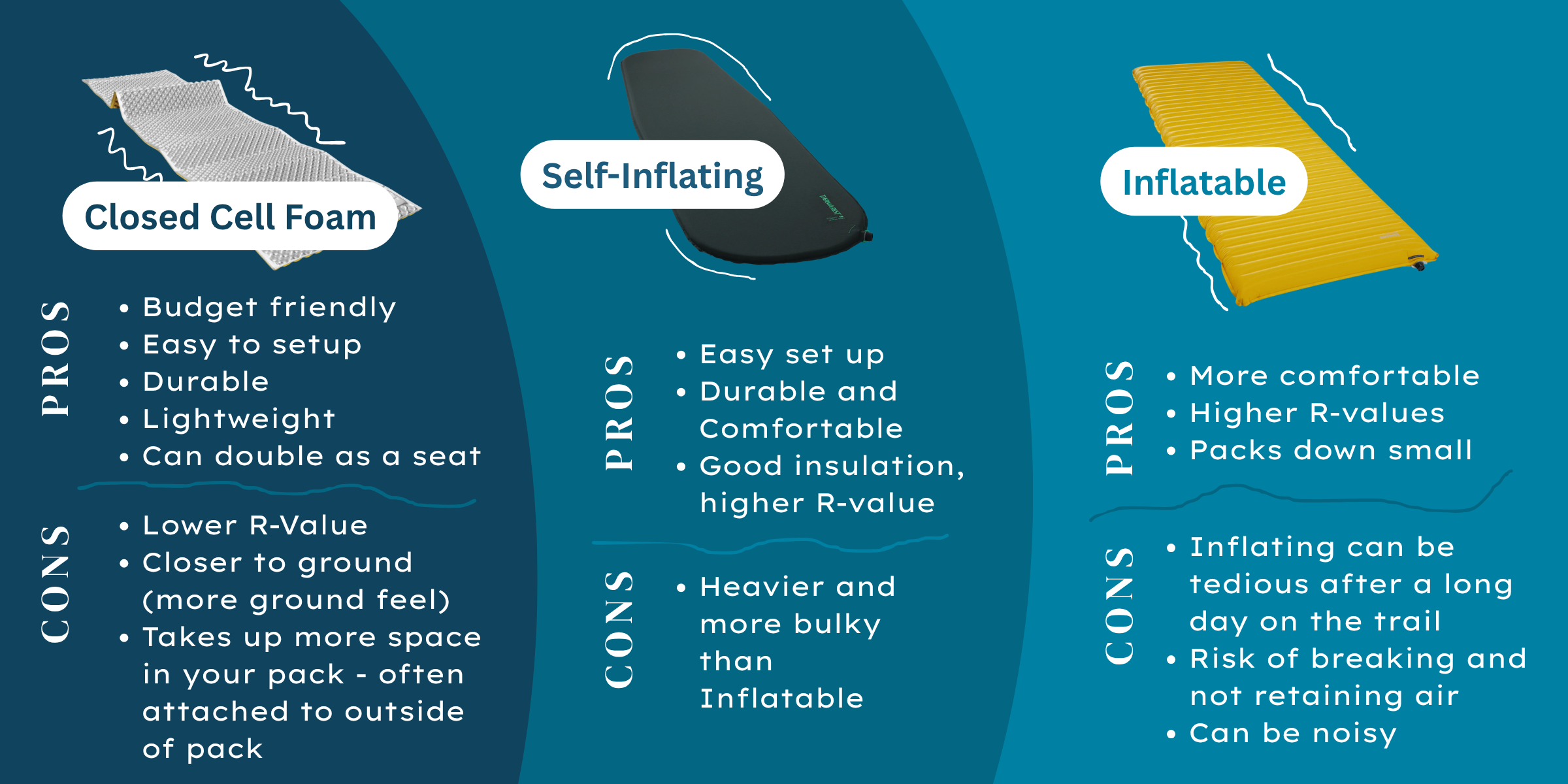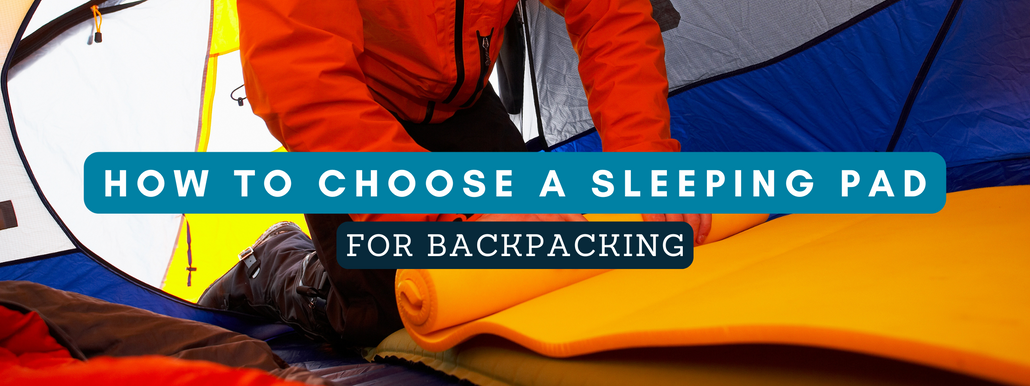How to Choose a Sleeping Pad for Backpacking
Posted by Kirsten on 2025 May 30th
When it comes to sleeping on the trail, your sleeping pad is a significant determining factor for your comfort level. Perhaps you won’t reach the same level of comfort as your bed at home, but you can get pretty darn close with the right gear. When we say the “right gear”, we mean the right gear for you.
Your sleeping pad is an essential part of your gear kit. You can invest in a highly rated sleeping bag, and dress in layers of merino wool, but if you are missing a quality sleeping pad, you may still be cold and uncomfortable. Creating space between your body and the ground is the key to increasing comfort.
As with all backpacking gear, you must first determine your priorities. Here are some questions to ask yourself:
- How do you sleep? (Side, Back, Stomach? Do you toss and turn?)
- Do you need added warmth?
- Is durability the most essential?
- Do you want to backpack ultralight?
These answers will help dictate your decisions moving forward. Choosing the lightest gear makes sense initially, but ultralight gear may not be in your budget, or you may require your gear to be more durable. Perhaps you’ve cut weight from other gear, so you can choose a thicker sleeping pad for a more comfortable sleep on the trail. There are a variety of factors to consider and ultimately, you are weighing pros and cons between quality, weight, functionality and comfort.
If you’re interested in learning about ultralight backpacking, we have a series of blogs to help you out. Read them here.

Here are 3 things to consider when choosing a sleeping pad:
- Your Body: Your height and how you sleep
- The Sleeping Pad Size: Weight and packable size
- The Season: R-Values

Your Body
When choosing a sleeping pad size, look at the length as well as the width of the pad. A regular length and width is typically 72 inches long and 20 inches wide. This can vary between brands. There are longer and shorter pads available depending on your body, and how you travel. Pads are classified as Regular, Regular Wide, Regular Mummy, Long, Long Wide or Long Mummy. There are also Women’s specific pads which are shorter, (commonly 66 inches in length),c and often offer more insulation, as women tend to run colder than men. A Women's 'Mummy' sleeping pad is also tapered differently, allowing more space at the hips.
A good rule of thumb for a comfortable fit is to select a pad that is a few inches longer than your height. If you need to save space or weight, some people will choose a sleeping pad that is too short and then utilize clothing or their backpack under their feet. When deciding on the width, how you sleep matters. If you move around a lot in your sleep, opting for a wider pad, (25 inches wide), is typically a smart choice.
In addition to the length and width of your sleeping pad, you should also note the thickness. Naturally, the comfort increases with the thickness. Side and stomach sleepers benefit from a thicker pad. The other reason to opt for a thicker mat is for more insulating properties. Warmth and comfort increase as you add space between your body and the ground.

The Sleeping Pad: Packed Size and Weight
Now you know how to choose a size that fits your body, the next step to narrow it down further is the packed size and weight of the pad. You need to envision your full gear kit to know how much space and weight your sleeping pad can utilize.
The shape of the sleeping pad comes into play here, and there are 2 distinct options: Rectangle and Mummy. A rectangle shape is the more comfortable of the two, with more space to move around, and the Mummy shape tapers at the feet resulting in less overall material allowing them to weigh less and pack down smaller. If you’re aiming for an ultralight experience, the Mummy shape is the one for you.
The Season (R-Values)
When you plan to camp is crucial as you must ensure you have proper insulation, particularly if you plan to winter camp. Sleeping pads come with a rating system called ‘R-Value’ (Thermal Resistance) to indicate their level of insulation. It is important to note that this rating system can sometimes indicate a survival rating, as opposed to a comfort rating, so double check the fine-print when researching sleeping pads. Furthermore, there is a standard methodology that brands use to determine sleeping pad ratings. It is known as ASTM F3340-18 R-Value Standard. It's a mouthful, but it's an important term to remember, and it's been in place since 2019. When you are comparing sleeping pads, take note if they have used the ASTM standard so you are confident comparing R-Values. The brands we carry at River & Trail Outdoor Co., (Big Agnes, Nemo, Sea To Summit, Therm-A-Rest), all use the ASTM F3340-18 standard.
- R Value 3 or less: Warm Weather, or 1 season
- R Value 3-4: 3-Season use
- R Value 4.5+: Winter weather
You can layer an insulated sleeping pad with a closed cell foam pad to increase warmth. Now, you may be wondering: ‘What is a closed cell foam pad?’ We explain this in the next section.

Inflatable, Self-Inflating and Foam Pads
There are self-inflating, inflatable sleeping pads and foam sleeping pads, and they each come with pros and cons. A closed-cell foam sleeping pad is made from dense foam and provides a lightweight, durable and easy option for insulation under your sleeping bag. Inflatable sleeping are typically more comfortable and require a more set up than a foam pad. Self-inflating pads are the happy medium between the two.
Reference the image below for Pros and Cons of each pad type.

In Summary
There are plenty of sleeping pad options with a variety of specs and features. Once you’ve defined your priorities, you can quickly narrow down your options so you can feel confident in your sleeping pad choice. All available sleeping pads at River & Trail Outdoor Co are listed here. Send us a message or visit us in store if you have any further questions!


